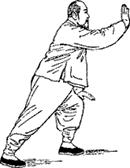welcome to WuTaijiquan.com
WuTaijiquan.com is a resource for Wu Family players of Taijiquan [Tai chi chuan].
Introduction
Wu Taiji Quan [tai chi chuan] is one of the five family styles of Taiji Quan. It was founded by Wu Jianquan (1870-1942), who was taught by his father Wu Quanyou, a student of Yan Luchan.
After long years of practicing and teaching, Wu Jianquan revised and enriched the art of Taiji Quan handed down from his family. Wu Taiji Quan includes forms such as the slow form, fast form, sabre form, spear and sword form and extensive pushhands.
Wu Yinghua (1907-1996), the daughter of Wu Jianquan, and her husband Ma Yueliang (1901-1998) dedicated their lives to the development and popularization of Wu Taiji Quan. This dedication is now carried on by the next generation.
Brief History
In 1850, Wu Quanyou (吳全佑, 1834–1902) was a Manchurian military officer cadet in the Yellow Banner camp in the Forbidden City, Beijing and also a hereditary officer of the Imperial Guards Brigade. At that time, Yang Luchan (楊露禪, 1799–1872) was the martial arts instructor in the Imperial Guards, teaching taiji quan.
In 1870, Wu Quanyou was asked to become the senior disciple of Yang Panhou (楊班侯, 1837-1890), Yang Luchan’s oldest adult son, and an instructor as well to the Manchu military.
Wu Quanyou's son, Wu Jianquan (吳鑑泉, 1870-1942), and grandchildren: grandsons Wu Gongyi, 吳公儀, 1900-1970 and Wu Gongzao, 吳公藻, 1902-1983 as well as granddaughter Wu Yinghua, 吳英華, 1906-1996 were well known teachers. Wu Jianquan became the most widely known teacher in his family, and is therefore considered the co-founder of the Wu style by his family and their students. He taught large numbers of people and his refinements to the art more clearly distinguish Wu style from Yang style training. Wu Jianquan moved his family south from Beijing (where an important school founded by other students of his father is headquartered, popularly known as the Northern Wu style) to Shanghai in 1928, where he founded the Jianquan Taiji Quan Association (鑑泉太極拳社) in 1935. Wu Gongyi then moved the family headquarters to Hong Kong in 1948, his younger sister Wu Yinghua and her husband, Ma Yueliang, 馬岳樑, 1901-1998, staying behind to manage the original Shanghai school. Between 1983 and her passing in 1996 Wu Yinghua was the highest ranked instructor in the Wu family system. Her sons continue teaching and today manage the Shanghai school as well as schools in Europe.
Wu Gongyi's children were also full time martial art teachers:
Wu Dakui, 吳大揆, 1923-1972 was active in the resistance to the Japanese invasion
of China, yet he later taught taiji quan in Japan after the war. His
younger brother, Wu Daqi, 吳大齊, 1926-1993, supervised the family's
Hong Kong and southeast Asian schools for many years and opened the family's
first western hemisphere school in Toronto, Canada in 1974. Wu Gongyi's
daughter, Wu Yanxia, 吳雁霞, 1930-2001, was known as an expert
with the taiji jian (sword), while her cousin, Wu Daxin,
吳大新, 1933-2005, was also known as a weapons specialist, particularly with
the taiji dao (sabre).
Training
The Wu style's distinctive hand form, pushing hands and weapons trainings emphasise parallel footwork and horse stance training with the feet relatively closer together than the modern Yang or Chen styles, small circle hand techniques (although large circle techniques are trained as well) and differs from the other taiji quan family styles martially with Wu style's initial focus on grappling, throws (shuai chiao), tumbling, jumping, footsweeps, pressure point leverage and joint locks and breaks, which are trained in addition to more conventional taiji sparring and fencing at advanced levels.
Another significant feature of Wu style training is its routinely placing the body's weight 100% on one leg; "yin and yang separation". The leg that supports 100% of the body weight is actually the yang leg, as this leg is "full". The yin leg is that which has no weight on it, it is "empty". It is also common in Wu style to maintain a straight line of the spine from the top of the head to the heel of the rear foot when it is at an angle to the ground; an inclined plane alignment intended to extend the practitioner's reach.
 links
links